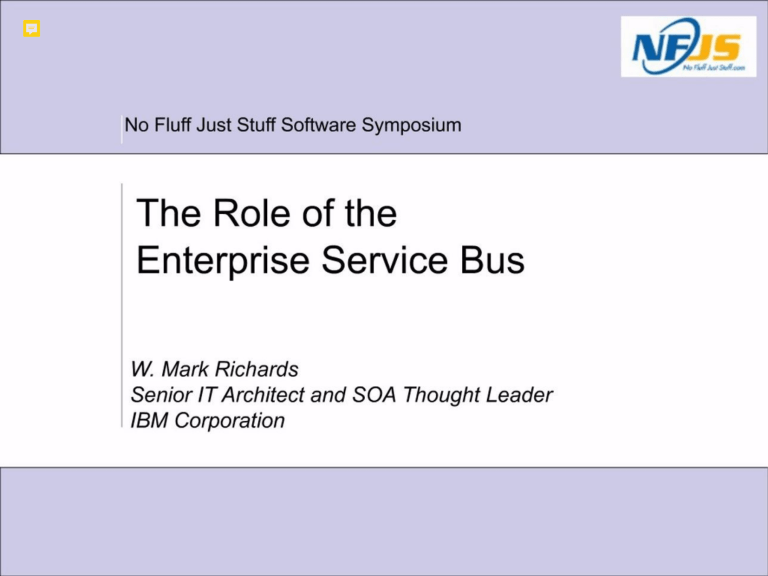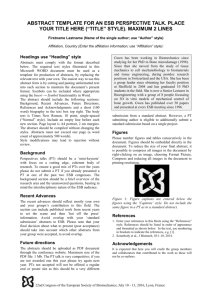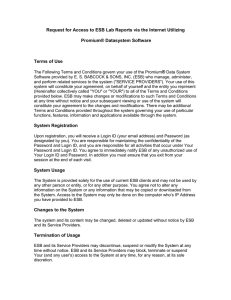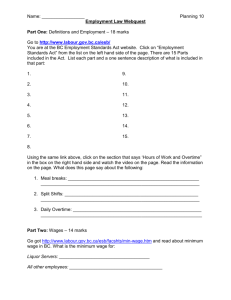
-.. NB ~ !i t ,_ r"JJw _. -- No Fluff Just Stuff Software Symposium The Role of the EnterpriseService Bus W Mark Richards Senior IT Architect and SOA Thought Leader IBM Corporation Introduction Agenda o o o o o o o o 2 Introduction The ESB as a Pattern for SOA Exploring the Capabilities of an ESB ESB Components Process Choreography and the ESB JSR-208 JBI Specification and the Impact on an ESB Open Source ESB Projects Summary The Role of The ESB Introduction The Role of The ESB What is an ESB? o o There is no industry-agreed upon definition of what an ESB is Some questions to consider : Is Is Is Is 4 it a Pattern? it a Product? it an Architectural Component? it a Hardware Component? (i.e. DataPower Xl50) Introduction How do the leading vendors define an ESB? o Let's look at the content from some actual websites .. . 5 The Role of The ESB Introduction The Role of The ESB Product Website 1: "[This ESB] is an enterprise service bus which simplifies the integration and flexible reuse of business components using a standards-based , serviceoriented architecture (SOA) . Free of the inflexible and costly customization required by other middleware technologies , [this ESB] lets architects dynamically configure the reliable connection, mediation and control of services and their interactions ." 6 Introduction The Role of The ESB Product Website 2 : "[This ESB] is an Enterprise Service Bus (ESB) and SOA toolkit built from the ground up on the semantics and APls of the Java Business Integration (JBI) specification JSR 208 . It is lightweight and easily embeddable, has integrated Spring support and can be run at the edge of the network (inside a client or server) , as a standalone ESB provider or as a service within another ESB . You can use [This ESB] in Java SE or a Java EE application server . The aim of [This ESB] is to allow integration components and services to be integrate in a vendor independent way, allowing users and vendors to plug and play. " 7 Introduction The Role of The ESB Product Website 3 : "[This ESB] offers the first end-to-end, 100°/oWeb services -based Enterprise Service Bus, spanning service creation through sophisticated service orchestration with native BPEL support . New features include deep support for a wide range of XML and Web services standards , Multi-protocol messaging , routing, and adapters, including full support for WS-Rel iableMessaging and the option of a fully integrated version of the JBoss JMS , extensive and intuitive transformation support for XML and non-XML applications and data , and complete support for BPEL 1.1 workflow and routing, including a suite of powerful Eclipse-based tools for the design, deployment, and management of complex workflows ." 8 Introduction The Role of The ESB How does Gartner define an ESB? "An Enterprise Service Bus (ESB) is a new architecture that exploits Web services, messaging middleware, intelligent routing, and transformation. ESBs act a a lightweight, ubiquitous integration backbone through which software services and application components flow." 9 Introduction The Role of The ESB Bottom line o o 10 There is no single concise definition of an ESB We will try to understand what an ESB is by understanding its role and capabili ties The ESB as a Pattern for SOA The Role of The ESB ESB Architecture Context o In the move towards SOA , client applications are decoupled from services. The ESB provides the communication bridge ... Client Ap plication Client Applicat ion ! II Enterprise Service Bus Service Provide r (Java/EJB) Serv ice Provider (GIGS/Mainframe) Serv ice Provider (Java/EJB) 12 Service Provide r (GIGS/ Mainf rame) The ESB as a Pattern for SOA The Role of The ESB The ESB Helps Facilitate The Following: o o o 13 Service Location Transparency Sharing of services across the enterprise Ability to separate Business Services from Service Implementations The ESB as a Pattern for SOA The Role of The ESB Business Service vs. Implementation Service Business Service Def Place Trade WSDL Client Application Place Trade Business Services are exposed to client as a service name and specified input and output structures (i.e. through WSDL) Enterprise Service Bus Implementation Services are coded within the Service Providers (i.e. through Java/EJB) save TradeOrder() V I I ••-• Serv ice Provider 14 Java Source Code for save TradeOrder() Roadmap The Role of The ESB Exploring the Capabilities of an ESB 15 ESB Capabilities The Role of The ESB ESB Core Capabilities Message Enhancement Message Transformation Routing Protocol Transformation ·----------------------..--- -- · --------- ---- Service Mapping Enterprise Service Bus -- ---- ---- ---- ---- -- ----- ~ Security Message Processing Transaction Management Process Choreography Service Orchestration 16 ESB Capabilities e8 Routing The ability to channel a request to a particular service provider based on deterministic or variable routing criteria Types of routing to consider Static or Deterministic Routing Content-based Routing Policy-based Routing Complex Rules-based Routing 17 The Role of The ESB Routing ESB Capabilities Message Transformation The ability to convert the structure and format of the incoming business service request to the structure and format expected by the service provider Some Examples Include: XM L D LJ XM L XM L D LJ COBOL Copybook Object 8 :J XM L 18 The Role of The ESB e8 Message Transformat ion ESB Capabilities The Role of The ESB e8 Message Transformation Message Transformat ion Incoming Request Service Provider Input <TradeRequest> <action>BUY </action> <symbol>NFJS< /symbol> <shares> 100 .0</shares> <price>50 .00</price> </TradeReques t> 01 TRADE-REQUEST 05 TRADE-I NFO 10 SIDE 10 TICKER 05 PRICE-INFO 10 SHARES 10 PRICE Output.SIDE = lnput .TradeRequest .action Output .TICKER= lnput .TradeRequest .symbol Output .SHARES = In put. TradeReq uest.shares Output .PRICE = lnput .TradeRequest .price 19 PIC X(10) PICX(4) PIC 9(11) PIC 9(11) ESB Capabilities Message Enhancement The ability to add or modify the information contained in the message as required by the service provider Types of Message Enhancement Date format conversion Supplement data not included in original message Data conversion (i.e. spaces to zero) Rules-based Enhancement 20 The Role of The ESB e8 Message Enhancement ESB Capabilities The Role of The ESB e8 Message Enhancement Message Enhancement Assume Exchange Code was required on Service Provider input Incoming Request Service Provider Input <TradeRequest> <action>BUY </action> <symbol>N FJS </symbol> <shares>100 .0</shares> <pr ice>50 .00</price> </Trade Request> 01 TRADE-REQUEST 05 TRADE-INFO t I[____ 10 EXCHNGE 05 PRICE-INFO 10 SHARES 10 PRICE PIC X(1) PIC 9(11) PIC 9(11) GetDatabaseConnection() Var.exchange= QueryExchangeCode(lnput.TradeRequest.symbol) Output.EXCHNGE = Var.exchange 21 ESB Capabilities ProtocolTransformation The ability to accept one type of protocol from the consumer as input (i.e. SOAP/JMS) and communicate to the service provider through a different protocol (i.e. I/OP) The Role of The ESB e8 Protocol Transformation A form of message transformation concerned with the message structure , not the message payload Has both physical connection attributes as well as logical connectivity attributes Examples SOAP/JMS DD IIOP XML/HTTP DD CIC S/MQ XML/HTTP OD RMI/ IIOP SOAP /MQ DD ATMI XML/HTTP DD OTMA 22 ESB Capabilities The Role of The ESB e8 Protocol Transformation Example: SOAP/HTTP fl D PeopleSoft/MQ Protocol Transformation //ESB Must be able to process HTTP GET or POST Request //Extract XML From SOAP SET Output.XMLPayload = SOAP.body.xml //Create Protocol-specific Message Structure SET Output .Properti es.MessageSe t=' l20ABTG002001 '; SET Output.Properties .MessageType='PSFN _ BNCB_ PEND ITM_CI'; SET Output.Propert ies.MessageFormat= 'CwXML'; SET Output .MQMD .Format ='MQHRF2 '; SET Output.MQRFH2 .(MQRFH2 .Field)Version= 2; SET Output.MQRFH2 .(MQRFH2 .Field)Format= 'MQSTR '; SET Output .MQRFH2 .(MQRFH2 .Field)NameValueCCSID= 1208; SET Output .MQRFH2 .(MQRF H2.Field)CodedCharSet ld=1208 ; SET Output.MQRFH2.mcd.Fmt= 'CwXML' ; SET Output.MQRFH2.mcd.Set= '120ABTG002001'; SET Output.MQRFH2.mcd.Type= 'PSFN_ BNCB_ PENDITM _ CI' ; • • • 23 ESB Capabilities Service Mapping The ability to translate a business service into the corresponding service implementation and provide binding and location information The Role of The ESB e8 Service Mapping Could be implemented through XML, a database, or embedded within the Mediator ESB component Usually contains the following core information Implementation Service Name Service Protocol and binding information Protocol-specific info (i.e. timeouts, failover location) Service-specific routing information 24 ESB Capabilities The Role of The ESB e8 Message Processing Message Processing The ability to manage state and perform request management by accepting an input request and ensuring delivery back to the client via message synchronization For updates this might require the use of XA or messaging sync points to ensure guaranteed message process ing and delivery - - Client Application Output Request Queue 1 Input Request Queue 25 i Enterprise Serv ice Bus - - Error Notification Queue f ESB Capabilities The Role of The ESB e8 Process Choreography The ability to manage complex business processes that require the coordination of multiple business services to fulfill a single business service request o Process Choreography Usually BPEL based Process Choreography can be thought of as a manifestation of a use case or business process PlaceFixed Income Trade CreateOrder 26 Each of the bus iness process nodes can be an independent business service SelectBid PlaceTrade ExecuteTrade ESB Capabilities The Role of The ESB Service Orchestration The ability to manage the coordination of multiple implementation services Service Orchestration Can be BPEL based but is usually implemented through inter-service communication or aggregate services Difference between Service Orchestration and Process Choreography is based on the type of service being coordinated Process Choreography Service Orchestration 27 n Business Services Implementation Service ESB Capabilities The Role of The ESB Transaction Management The ability to provide a single unit of work for a business service request by providing a framework for the coordination of multiple resources across multiple disparate services Transaction Management Specifically, the ESB should provide a compensatory transactional framework for a service request WS-Coordination JSR-95 Activity Service 28 ESB Capabilities The Role of The ESB e8 Security The ability to protect enterprise services from unauthorized access Security In SOA there are no more silos; services become visible to the entire enterprise through the ESB The 4 "A's" of Security Authentication Authorization Auditing Administration ESB should provide authentication, authorization, and auditing ESB should access a security manager for authentication and authorization rather than have the direct responsibility 29 Roadmap The Role of The ESB ESB Components 30 ESB Components The Role of The ESB ESB Components o There is no one single product that can effectively do all of the o capabilities required of an ESB An ESB can be broken down into the following components Mediator Service Registry Choreographer Rules Engine ESB Mediator t Choreographer 31 Rules Eng ine Service Registry ESB Components The Role of The ESB Component Responsibilities Mediator Routing Comm unication ESB Message Transformation Mediato r Message Enhancement Protocol Transformation Message Processing Error Handling h Service Orchestration Transaction Management Security 32 ESB Components The Role of The ESB Component Responsibilities Service Registry ESB t Service Registry h Can be used for Policy-based information 33 Serv ice Mapping ESB Components The Role of The ESB Component Responsibilities Choreographer ESB t Choreograp her Message Processing* Process Choreog raphy Transaction Management* Secu rity* * Choreographer wo uld be respo nsible for these capa bilities only if it is the entrypoint into the ESB 34 ESB Components The Role of The ESB Component Responsibilities Rules Engine Routing* ESB Message Transformation* Message Enhancement * h Rules Engine * Specifica lly Rules-based Routing, Message Transformation, and Message Enhancemen t 35 Roadmap The Role of The ESB Process Choreography and the ESB 36 Process Choreography The Role of The ESB Considerations o Should process choreography sit above or below the Mediator? Choreography as the ESB Entry Point Mediator as the ESB Entry Point Either as an ESB Entry Point Recommendation Mediator as the ESB Entry Point (Choreography Below) Based on small 0/o of services that must be choreographed Better Performance Better Scalability Less Complexity 37 Process Choreography The Role of The ESB Choreography / Mediator Relationship Mediator As The ESB Entry Point Advantages o o o Client Application ESB Med iator i Choreog rapher Service Registry Service Prov ider 38 Good Performance Good Scalability Reduced Complexity : Only those services requiring Choreography go through the Choreographer Process Choreography The Role of The ESB Choreography / Mediator Relationship Choreography As The ESB Entry Point Considerations Client Application o o Performance Issues Maintenance Issues Complexity Issues ESB o Do ALL services require BPELbased process coordination? Choreographer Service Registry Mediator Service Provider 39 Process Choreography The Role of The ESB Chor eography / Med iator Relationship Choreographer and Mediator As The ESB Entry Point Considerations Cl Client responsib le for determining Clie nt Applica tion + ... .. ESB / 7 i Choreog rapher Mediator r- --- Message Process ing Transact ion processing Security No good separation of respons ibility within ESB components Service Registry Service Provider 40 service character istics Capabi lities shared by multiple ESB components Process Choreography The Role of The ESB Additional Considerations o Choreography contains business logic - does it really belong in an ESB? ESB is an infrastructure component Should business rules reside outside the ESB in the client? 41 Roadmap JSR-208 JBI Specification and the Impact on an ESB 42 The Role of The ESB Java Business Integration (JBI) The Role of The ESB Java Business Integration (JBI) Specification o o The goal of JBI is to create a standards-based architecture for integrating middleware components to perform ESB capabilities The JBI Spec is not concerned about how external consumers or service providers interact, but rather how internal consumers and providers interact o o JBI is dependent on J2SE but not J2EE JBI defines two types of components Service Engines (SEs ) Binding Comp onents (BCs) 43 Java Business Integration (JBI) The Role of The ESB JBI Specification Architecture BC BC BC BC JMXAdm in Tools Installation Normalized Message Router Deployment .., SE 44 Control SE SE Monitor ing Java Business Integration (JBI) The Role of The ESB JBI Specification Architecture Trading Desk (Java/Swing ) Trade Mgmt (Java/EJB) Portfolio Mgmt (COBOL /Cl CS ) Publish ing (Serv let) jbiESB ® JMXAdmin RMI/IIOP MQ HTTP CICS Tools i Installation NormalizedMessage Router Deployment Control XSLT 45 PXE Groovy Monitor ing Java Business Integration (JBI) The Role of The ESB JBI Advantages and the effect on Commercial ESBs o Third-party or Custom Service Engines (SE) and Binding Components (BC) can be swapped in and out without impacting applications or • services o o o o Avoids "Vendor Lock-in " Allows for "Best of Breed" technologies and solutions We can mix Open Source and Commercial solutions We can swap in and out integration services (i.e. capabilities) we don 't need, creating a lighter-weight solution that meets our specific needs o Is this the wave of the future for ESBs? 46 Roadmap The Role of The ESB Open Source ESB Projects 47 Open Source ESB Projects Open Source ESB projects o Mule o ServiceMix 48 The Role of The ESB Open Source ESB Projects The Role of The ESB Mule o o Lightweight Messaging Middleware Framework that manages UMOs (Universal Messaging Objects) UMOs contain communication endpoints that know how to receive and send requests Mule Container UMO UMO External Serv ice Provider Appl ication Application 49 Open Source ESB Projects The Role of The ESB ServiceMix o Open Source JBI-Compliant ESB JMXAdmin Tools Installation WSIF Deployment JavaMail Control Monitoring HTTP File ActiveSOAP Normal ized Message Ro uter Drools 50 PXE JCache Groovy Quartz XSLT Summary The Role of The ESB What have we learned? There is a beer made by Redhook called ESB An ESB can defined through its capabilities , specifically the ones important to us Reviewed 10 Core Capabilities and what they really mean Reviewed the components that make up an ESB and the capability mapping for each component How Choreography can play a part within an ESB What is JBI all about (Standards-based Pluggable Architecture) Open Source Solutions 52 Summary Closing and Q&A References http://www.redhook .com Mule - http://mule.codehaus .org ServiceMix - http://servicemix .org Please fill out the session evaluation W. Mark Richards - wrichard@us .ibm.com 53 The Role of The ESB





